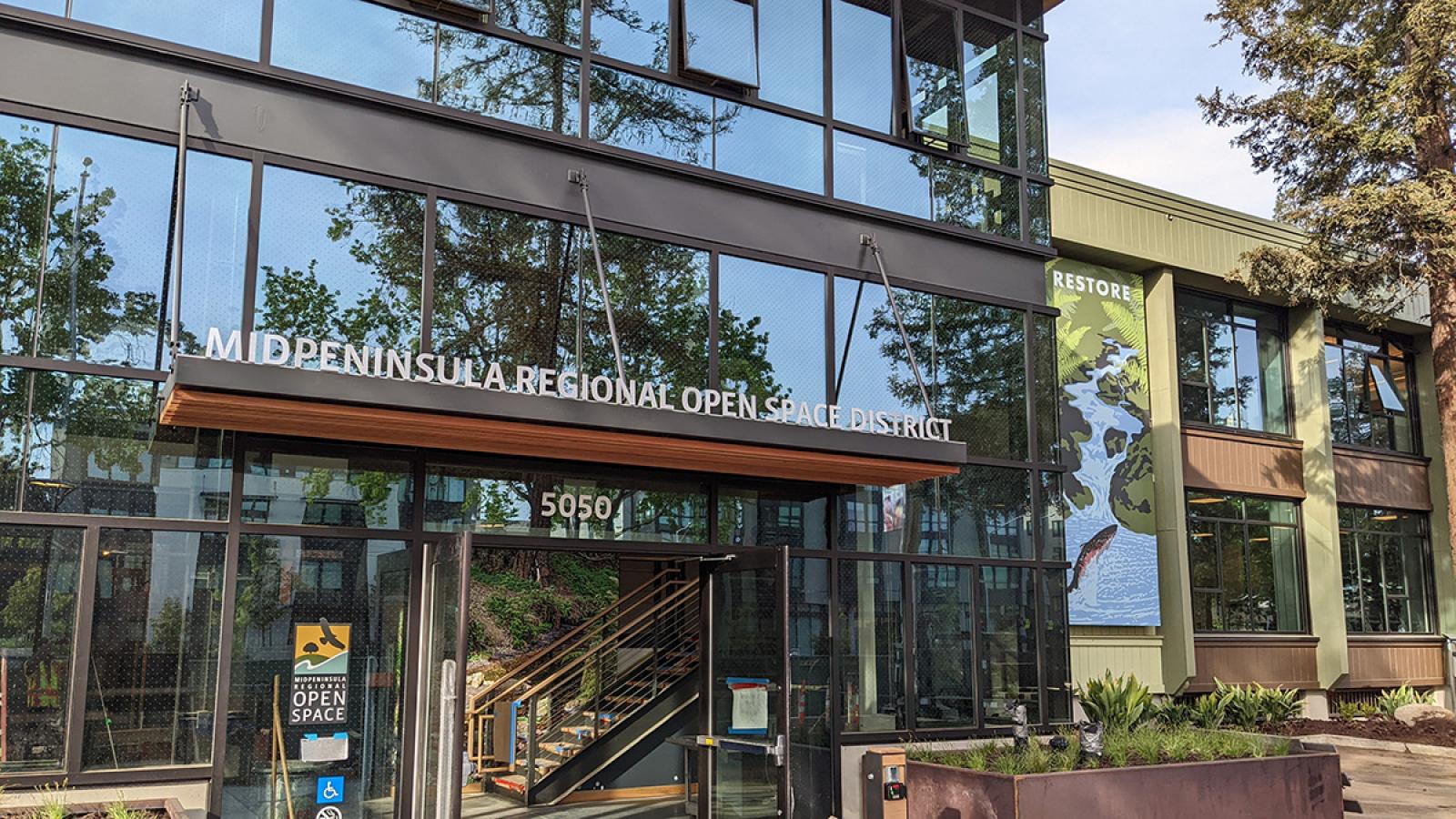The Midpen administrative offices were designed with sustainability in mind. Learn more about the sustainable design of the building:
Renovation of an existing property was the sustainability decision with the largest impact. Midpen staff determined that the sum of materials and efforts to construct an equivalent new facility would have added approximately 6,300 metric tons of carbon dioxide equivalent units into the atmosphere. Opting to breathe new life into this building reduced the embodied carbon by more than 50%.
Solar panels on the roof generate green power.
Building design exceeds rigorous CALGreen requirements and meets Leadership in Energy and Environmental Design (LEED) Gold benchmarks where possible. Due to the significant cost to taxpayers, Midpen’s board of directors declined to pursue formal LEED certification. The design of the building includes most of the LEED energy and water efficiency elements and places emphasis on elements that promote indoor environmental quality. The building was also constructed in an environmentally friendly manner by opting to use materials in the building for which lifecycle information is available and that have environmentally, economically and socially preferable life-cycle impacts where possible.
The beams surrounding the skylight are made from reclaimed lumber from the Alma College site at Bear Creek Redwoods Open Space Preserve.
Interior wall panels in the lobby are made from reclaimed redwood lumber. Reclaimed wood offers a range of sustainability advantages over new wood, reducing the need to cut living trees to obtain wood. It also keeps valuable resources from being landfilled and repurposes wood deemed less worthy. Reclaimed wood has much lower emissions than typically associated with the logging, transport and processing of new wood.
Bird-safe window glazing was employed at strategic locations where birds are particularly vulnerable, (as identified by the Audubon Society’s analysis). The bird-safe glazing is employed on the north side of the building facing El Camino Real because this side has trees and shade that attract birds. The south side of the building has no trees or shade. In addition, the south side second floor windows are recessed from the overhang. Studies show that birds generally don't fly into windows under overhangs.
Insulating window glazing reduces heat and cold transfer, which in turn reduces energy spent on heating and cooling.
Operable windows allow for natural ventilation, improve window efficiency and reduce HVAC energy use. When operable windows are open, the HVAC system automatically shuts down in the area. The HVAC system also has a wildfire mode, which stops bringing in outside air when activated, and a COVID-19 mode, which reduces the number of areas in the building where air cross-circulates.
The entryway to Midpen’s administrative offices is landscaped with drought-tolerant native plants such as California fuchsia (Epilobium canum), California wax myrtle (Morella californica), California lilacs (Ceanothus sp.) and more.
Exterior benches were made of reclaimed lumber from the Mount Umunhum Summit, which was removed as it was weathering quickly in the harsh environment at the top of the mountain.
The centrally placed skylight over the public atrium brings in filtered, dispersed daylight so that fewer internal lights are required, saving energy and reducing costs.
Midpen installed highly efficient HVAC units that provide passive and active air circulation through the building. Additionally, large fans in the atrium and lobby areas move air efficiently through the building, reducing dependence on power blowers to move air in those areas.
Exterior metal sunshades in the rear of the building reduce direct light, heat transfer and strain on the HVAC system.
Midpen employed motion-sensor LED lighting throughout the building to reduce energy usage.
Midpen installed a new roof, which improves insulation, reduces energy usage and costs, and weatherproofs the building.
Water efficient plumbing features were installed in all bathrooms and kitchens.
Midpen refurbished and reused good condition furniture and cubicle walls to furnish the new administrative office, giving new life to items that may have otherwise ended up in a landfill.

